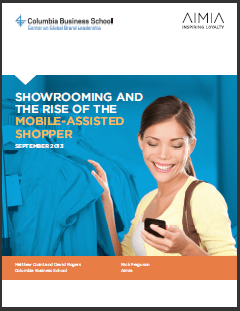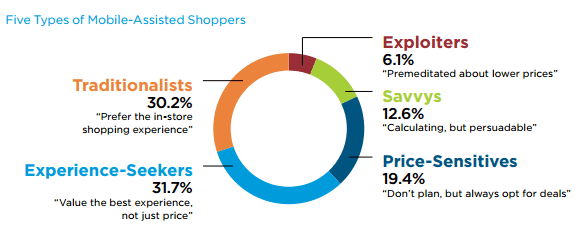 I am delighted to release the results of a new global study on the impact of smartphones on shopper behavior in retail stores — “Showrooming and the Rise of the Mobile-Assisted Shopper.” (Download here.)
I am delighted to release the results of a new global study on the impact of smartphones on shopper behavior in retail stores — “Showrooming and the Rise of the Mobile-Assisted Shopper.” (Download here.)
(Bloomberg BusinessWeek is reporting our findings this morning.)
As brick-and-mortar stores continue to struggle with the rise of “showrooming” consumers – those visiting a store to see a product, but purchasing it later online – our research reveals concrete steps that retailers can take to entice consumers armed with mobile devices to make purchases inside their store walls.
With my co-authors, Matthew Quint and Rick Ferguson, we were able to survey the behaviors and motivations of 3,000 leading-edge consumers in 3 countries, who represent the “omni-channel” future of retail.
Our findings contradict many of the common assumptions about the threat of “showrooming”, and reveal five distinct segments of mobile-assisted shoppers. We also identify clear opportunities for retailers to engage and retain these tech-savvy customers.
The Truth about Showrooming & Mobile-Assisted Shoppers
- M-Shoppers are already mainstream: 21% of consumers in the US, UK, and Canada are “M-Shoppers,” using mobile devices in stores to assist their shopping experience.
- It’s not just the Millennial Generation: Contrary to popular belief, 74% of M-shoppers are older than 29 years old.
- Mobile devices can actually improve the chances of an in-store purchase: Over 50% of M-Shoppers are more likely to purchase a product in-store when their mobile device helps them get online reviews, information, or trusted advice.
- Price isn’t always the most important factor: Although “price checking” is the number one action of M-Shoppers, convenience, urgency, and immediacy are the top three reasons why M-Shoppers will buy in-store even if they find the same product cheaper online.
- Loyalty programs are worth more than just their points: 48% of M-Shoppers say that being a member of a store’s loyalty program makes them more likely to purchase products in-store, despite equal or cheaper prices online.
Luring Back the Five Segments of Mobile-Assisted Shoppers
Our research found that there are five distinct types of mobile-assisted shoppers and uncovered clear opportunities for retailers to engage and retain the business of these tech-savvy customers. (See chart below.)

- The Exploiters – “premeditated about lower prices”: It would be easy for retailers to write off the Exploiters as a lost cause. But the best opportunity for retailers to win their business may simply be to improve the store’s website. When Exploiters see a product on the shelf and pull out their mobile device, they are nearly as likely to search for it on the store’s own website as on a competitor’s site (69% vs. 77%).
- The Savvys – “calculating, but persuadable”: Although they currently represent only 13% of mobile-assisted shoppers, Savvys are the ripest target for retailers to try out new offers and experiences in the mobile space. They are simultaneously more digitally savvy, more willing to sign up for loyalty programs, and more likely to be motivated by a range of retailer offers and rewards.
- The Price-Sensitives – “don’t plan, but always opt for deals”: Price-Sensitives use their devices in stores periodically, but not as consistently as the other segments. Often, the right in-store experience will be enough to earn the Price-Sensitives’ business. Their mobile devices may be with them but still remain in their pockets and purses.
- The Experience-Seekers – “value the best experience, not just price”: As the largest of all the segments, Experience-Seekers point to the opportunity for retailers to engage customers on their mobile devices in non-financial ways, with opportunities to comment, provide ratings, etc. And they demonstrate why retailers still need to invest in providing a unique and compelling in-store experience.
- The Traditionalists – “prefer the in-store shopping experience”: These shoppers are committed to purchasing in-store, making them the least threatening segment of mobile-assisted shoppers for retailers. They are open to interacting with retail stores on their mobile devices, whether by website, store app, or even scanning a QR code. But, they are currently using their devices mostly to consult on purchases with friends and family.
Today, retailers know they are operating in a new world where the shopper in your store with a smartphone has access to every competing outlet and offer. But they are not powerless. To survive, it is critically important that retailers understand the real impact of smartphones on shopper behavior, which will allow them to shape a retail experience that gives mobile consumers a reason to buy in a brick-and-mortar store.
SPONSORS:
The “Showrooming and the Rise of the Mobile-Assisted Shopper” research study was sponsored by Columbia Business School’s Center on Global Brand Leadership (www.globalbrands.org), and by global loyalty experts Aimia (www.aimia.com).
Happy reading!
David




Pingback: Reverse Showrooming can help both customers and retailers get what they need | High Fashion Average Woman